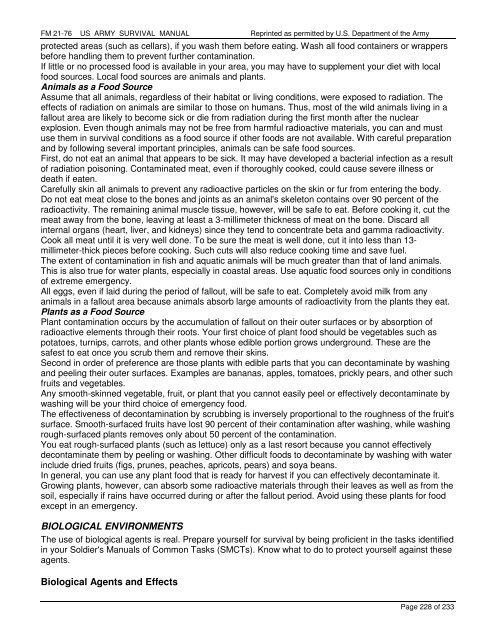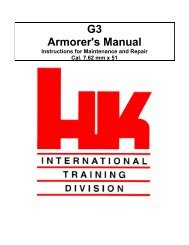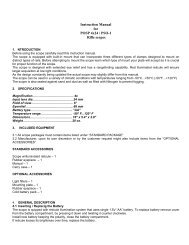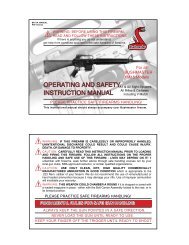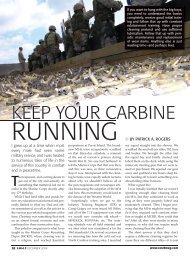FM 21-76 US ARMY SURVIVAL MANUAL - AR15.com
FM 21-76 US ARMY SURVIVAL MANUAL - AR15.com
FM 21-76 US ARMY SURVIVAL MANUAL - AR15.com
You also want an ePaper? Increase the reach of your titles
YUMPU automatically turns print PDFs into web optimized ePapers that Google loves.
<strong>FM</strong> <strong>21</strong>-<strong>76</strong> <strong>US</strong> <strong>ARMY</strong> <strong>SURVIVAL</strong> <strong>MANUAL</strong> Reprinted as permitted by U.S. Department of the Army<br />
protected areas (such as cellars), if you wash them before eating. Wash all food containers or wrappers<br />
before handling them to prevent further contamination.<br />
If little or no processed food is available in your area, you may have to supplement your diet with local<br />
food sources. Local food sources are animals and plants.<br />
Animals as a Food Source<br />
Assume that all animals, regardless of their habitat or living conditions, were exposed to radiation. The<br />
effects of radiation on animals are similar to those on humans. Thus, most of the wild animals living in a<br />
fallout area are likely to become sick or die from radiation during the first month after the nuclear<br />
explosion. Even though animals may not be free from harmful radioactive materials, you can and must<br />
use them in survival conditions as a food source if other foods are not available. With careful preparation<br />
and by following several important principles, animals can be safe food sources.<br />
First, do not eat an animal that appears to be sick. It may have developed a bacterial infection as a result<br />
of radiation poisoning. Contaminated meat, even if thoroughly cooked, could cause severe illness or<br />
death if eaten.<br />
Carefully skin all animals to prevent any radioactive particles on the skin or fur from entering the body.<br />
Do not eat meat close to the bones and joints as an animal's skeleton contains over 90 percent of the<br />
radioactivity. The remaining animal muscle tissue, however, will be safe to eat. Before cooking it, cut the<br />
meat away from the bone, leaving at least a 3-millimeter thickness of meat on the bone. Discard all<br />
internal organs (heart, liver, and kidneys) since they tend to concentrate beta and gamma radioactivity.<br />
Cook all meat until it is very well done. To be sure the meat is well done, cut it into less than 13millimeter-thick<br />
pieces before cooking. Such cuts will also reduce cooking time and save fuel.<br />
The extent of contamination in fish and aquatic animals will be much greater than that of land animals.<br />
This is also true for water plants, especially in coastal areas. Use aquatic food sources only in conditions<br />
of extreme emergency.<br />
All eggs, even if laid during the period of fallout, will be safe to eat. Completely avoid milk from any<br />
animals in a fallout area because animals absorb large amounts of radioactivity from the plants they eat.<br />
Plants as a Food Source<br />
Plant contamination occurs by the accumulation of fallout on their outer surfaces or by absorption of<br />
radioactive elements through their roots. Your first choice of plant food should be vegetables such as<br />
potatoes, turnips, carrots, and other plants whose edible portion grows underground. These are the<br />
safest to eat once you scrub them and remove their skins.<br />
Second in order of preference are those plants with edible parts that you can decontaminate by washing<br />
and peeling their outer surfaces. Examples are bananas, apples, tomatoes, prickly pears, and other such<br />
fruits and vegetables.<br />
Any smooth-skinned vegetable, fruit, or plant that you cannot easily peel or effectively decontaminate by<br />
washing will be your third choice of emergency food.<br />
The effectiveness of decontamination by scrubbing is inversely proportional to the roughness of the fruit's<br />
surface. Smooth-surfaced fruits have lost 90 percent of their contamination after washing, while washing<br />
rough-surfaced plants removes only about 50 percent of the contamination.<br />
You eat rough-surfaced plants (such as lettuce) only as a last resort because you cannot effectively<br />
decontaminate them by peeling or washing. Other difficult foods to decontaminate by washing with water<br />
include dried fruits (figs, prunes, peaches, apricots, pears) and soya beans.<br />
In general, you can use any plant food that is ready for harvest if you can effectively decontaminate it.<br />
Growing plants, however, can absorb some radioactive materials through their leaves as well as from the<br />
soil, especially if rains have occurred during or after the fallout period. Avoid using these plants for food<br />
except in an emergency.<br />
BIOLOGICAL ENVIRONMENTS<br />
The use of biological agents is real. Prepare yourself for survival by being proficient in the tasks identified<br />
in your Soldier's Manuals of Common Tasks (SMCTs). Know what to do to protect yourself against these<br />
agents.<br />
Biological Agents and Effects<br />
Page 228 of 233


